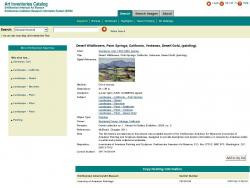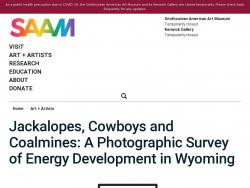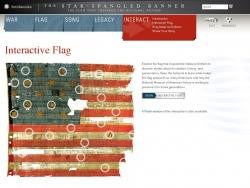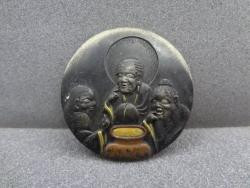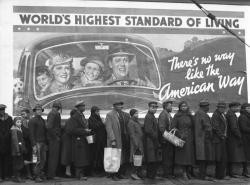Kate Harris
Social Studies teacher
Pittsburgh CAPA
Middle School (13 to 15 years old), High School (16 to 18 years old)
Teacher/Educator
Language Arts And English, Civics, Literature, Cultures, Economics, Social Studies, Geography, Writing, US History, Arts, Other
I'm a history-lover, art fan, and bookworm. I taught high school history (U.S. History and World Religions) for ten years in North Carolina, teach currently in Pittsburgh, PA, and am working to help teachers make the most of this new resource!
Kate Harris's collections
Cold War Fears
<p>This is a topical collection about American fears during the Cold War. What were Americans afraid of? How were these fears expressed in United States culture? How successfully did the government address these fears?</p><p><br /><br /></p><p>Students and teachers may want to explore the resources in this collection to consider the psychological impact of the Cold War and how Americans prepared themselves for the unknown. </p><p><br /><br /></p><p>Tags: Cold War, McCarthy, UFOs, aliens, space race, fallout shelters, Civil Defense, radiation, spies, Hiss, Rosenberg, Murrow, Sputnik, cause and effect</p>
 Kate Harris
Kate Harris
15
Who provoked the Korean War?
"On June 25, 1990, the North Korean Army launches it surprise assault on the South." But what led up to this moment? This activity asks students to read primary source documents and interpret historical events surrounding the Korean conflict. Students will look for motives and evidence in a variety of accounts and determine who was responsible for starting the Korean War. <br />
<br />
There are resources with quiz questions that students can answer directly, or teachers may prefer to print documents and resources for in-class use. It is recommended that teachers preview the materials in this teaching collection as there are a variety of ways to structure the lesson.<br />
<br />
Essential questions include:<br />
-How would you describe the relationship between Kim Il Sung and Joseph Stalin?<br />
-Was North Korea, a smaller country, pulling a superpower into a conflict?<br />
-Was the Soviet Union using North Korea to further its goals?<br />
-Why did the United States choose to respond via the United Nations forces instead of unilaterally? How did this decision impact the conflict?<br />
-How does this incident reflect larger themes and issues of the Cold War, especially the role of the United Nations, over-arching foreign policy strategy, and nuclear fears?<br />
<br />
Tags: Wilson Center, Cold War, Korea, China, Truman, Eisenhower, Macarthur, Soviet Union, USSR, Communism
 Kate Harris
Kate Harris
17
Origin Stories from Around the World
<p> Creation myths, or origin stories, tell us what a culture believes about how humans came to be. They can also tell us much about what that culture values. These are often religious or spiritual explanations for human life. </p><p>Choose one of origin stories on this page to focus on. Read, watch, or listen to the story. Then, create a visual that illustrates a scene in the story that you think is revealing about that culture's values. Finally, write a paragraph summarizing what you learned about that culture based on their origin story.</p><p>To recap:</p><p>1. Read/watch listen.</p><p>2. Create a visual of 1 scene in the story. </p><p>3. Write a paragraph summarizing what you learned about that culture based on their origin story. <br /></p>
 Kate Harris
Kate Harris
8
3D Technology and Repatriation of the Kéet-S’aaxw
<p>This student activity introduces students to the concept of repatriation of cultural heritage items to the tribes to whom they belong, and the ways that museums and Native American groups are now using 3D technology to aid in the process. A killer whale hat, or kéet-s'aaxw, was requested to be repatriated by members of the Tlingit tribe. The Smithsonian Institution, under the repatriation provisions of the National Museum of the American Indian Act, did so. In the years following, the clan's leader decided that it might be beneficial to 3D scan the image in order to preserve its details and protect it in case of loss or fire. Having this data allowed the museum to create an accurate replica to be used for educational purposes, and provided the tribe with peace of mind. Learn more about this story and other cases of repatriation and replication in this collection which includes a 3D model and tour, video, website, and images of objects that have been part of the process. </p>
<p>Essential Questions include:</p>
<ul><li>How does the current process of repatriation reflect a change in traditional relationships between museums and indigenous groups?</li><li>What kinds of guidelines should be used to determine which objects should be repatriated?</li><li>What benefits does 3D technology provide for museums and Native American tribes? Can you envision other scenarios where 3D technology might play a similarly beneficial role?</li></ul><p>Tags: Native American, American Indian, Tlingit, repatriation, replication, 3D technology, whale hat, indigenous, rights, change over time, museums, anthropology</p>
 Kate Harris
Kate Harris
10
Robber-Baron or Captain of Industry: Andrew Carnegie
<p>This collection includes different perspectives and information about Andrew Carnegie. Students are challenged to build an argument supporting one position or the other: Robber-Baron or Captain of Industry--using the resources as evidence. <strong>Was Carnegie an industrialist who desired to get rich and promote himself regardless of the effects on his workers? Or was he an example of the American dream, an industrial leader who improved the nation and helped its people?</strong></p>
<p>Investigate the items in this collection while thinking about those questions. After an initial review of the collection, complete the sorting activities at the end to test your understanding of the issue and begin to develop an argument reflecting your answer to the question above. </p>
 Kate Harris
Kate Harris
19
Carlisle Indian Industrial School
<p>Perhaps the most famous of the Indian boarding schools created in the late 19th century, the Carlisle Indian Industrial School in Pennsylvania was founded by Captain Richard Henry Pratt (with funding and support from the United States government), with the purpose of assimilating (or Americanizing) Indian students. </p><p>Student will use archival materials to explore student life at Carlisle Indian School and to evaluate assimilation policy as practiced through the school. <strong>What was gained and lost through the process of assimilation? </strong></p><p>Using these resources as a starting point, users should research one former Indian student or one aspect of student life using the <a href="http://carlisleindian.dickinson.edu/" target="_blank">Carlisle Indian School Digital Resource Center</a>. Many student files record not only experiences that occurred while at the school, but information about occupations and life after the boarding school experience. Were students and families able to shape positive experiences despite the intended consequences of boarding school policy? </p><p><span>Students should create a writing or artwork that reflects information learned about that particular student or activity and that shares the learner's opinions on assimilation policy and the response of Native Ameri</span><span>cans</span><span>. </span><strong>How should the Carlisle Indian School be remembered? </strong></p><p>Tags: Native American, Indian, boarding school, assimilation, Pratt, Dawes Act, Jim Thorpe, allotment</p>
 Kate Harris
Kate Harris
32
The 1950s--A Decade Collection
<p>This is a topical collection about American life and politics in the 1950s. Resources in this collection might be helpful to students and teachers working on projects about the decade. It is not meant to be completely comprehensive, but rather includes highlights of the Smithsonian's collection spanning art, popular culture, social trends, leadership, and technology. </p><p>Teachers and students might copy and adapt this collection to suit their needs; highlighting a specific aspect of life in the 1950s and adding annotations and additional resources. </p>
 Kate Harris
Kate Harris
80
Do our national symbols accurately reflect our nation?
<p>After the War of 1812, a set of new national symbols were revered. These symbols, including the flag and the song that would be come the national anthem, demonstrated a sense of pride in a nation that had now defeated the British twice and would be an experiment in liberty and freedom. Use the items in this collection to learn about the history of these symbols. Do they accurately reflect the ideals of the nation in the early 19th century? Do they accurately reflect the realities of life in the nation at that time?</p>
<p>Lately, the national anthem and athlete protests during the anthem have been the subject of some controversy. What are your personal feelings about the flag and/or anthem? Consider how learning the historical background of the song might impact your opinion on these anthem protests. </p>
 Kate Harris
Kate Harris
11
Sports and the African-American Civil Rights Movement
Popular athletes can reflect the broader societal change that is going on around them; they can also be instigators of that change. This collection traces the African-American civil rights movement through the 20th century and touches on athletes like Jack Johnson, Jackie Robinson, and Muhammad Ali. Students can use the collection independently to learn about this subject and complete the timeline worksheet included at the end.
Students will be asked to generalize about the civil rights movement during different time periods in American history, noting the shifts in focus, strategies, and success. In addition, they will draw parallels between events in sports history and the civil rights movement.
 Kate Harris
Kate Harris
18
Iconic and Ironic? Depression-Era Photographs
<p>This collection includes three photographs by Farm Security Administration artists that use language and image to create an American scene in the late 1930s-early 1940s. The first has become an iconic image of the Great Depression by Margaret Bourke-White, although it has a more specific history that users will learn about. Students will be asked to consider why the first image became so closely linked with the Great Depression, how the artist and author used irony to make a statement, and how different groups may have experienced the Depression in different ways. After reading a passage from Bud Not Buddy (by Christopher Paul Curtis) and answering reflective questions, students will write their own passage about one of the remaining photographs.</p><p>Essential Questions:</p><p>-How do these artists use images and language to create rich portraits of America?</p><p>-In what way do these images suggest divisions or unity within America during hte 1930s and 1940s?</p><p>Tags: Bud Not Buddy, Margaret Bourke White, Dorothea Lange, Ben Shahn, Farm Security Administration, soup kitchen, bread line, hobo, hoboes, comparison, irony, descriptive writing</p>
 Kate Harris
Kate Harris
6
The Steamboat Arabia
<p style="margin-left:32px;">This collection was made to pair with a learning experience during the November 17th workshop for Pittsburgh teachers working with the Smithsonian Learning Lab. Teachers will visit the Steamboat Arabia exhibit and learn from a Heinz History Center curator about the decisions made and limitations faced when creating an exhibit for visitors to learn from. </p><p style="margin-left:32px;">Both the online collection and the Heinz History Center exhibit explore the question "<strong>How do new innovations in transportation affect American life?"</strong></p><p style="margin-left:32px;">The collection below contains artifacts and images from the Smithsonian collection that might help students and teachers respond to the question above. Suggested scaffolding questions might include:</p><ul><li>Identify the changes in technology and transportation that occurred between 1800-1850.</li><li>How did these new transportation systems impact the movement and interactions of groups of people, the expansion of trade, and cultural life on the frontier?</li><li>How do the items in this collection compare to what was found during the recovery of the Steamboat Arabia?</li></ul>
 Kate Harris
Kate Harris
22


